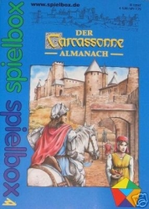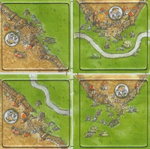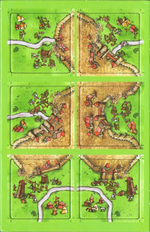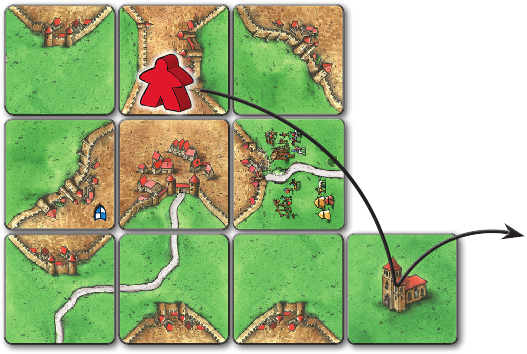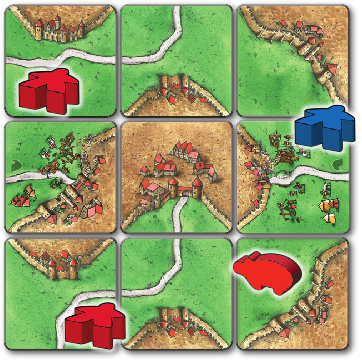Katarzy, Oblężniczy i Oblężenie (1. edycja)
 |
You are reading the rules for this tile design. |  |
| This expansion was not published in other editions. |
| If your tiles have a different design, then choose a game from Spin-offs. |  |
During the 11th and 12th centuries, a new religion called Catharism developed in southern France. The Roman Church decreed that this religion was heretical. By the beginning of the 13th century Carcassonne had become a stronghold of the Cathar religion. After unheeded warnings and the murder of a church legate, Pope Innocent III initiated a crusade against the Cathars. The besieging of Carcassonne in 1209 marked the start of 40 years of continuous war.
General info and comments
The Cathars (Die Katharer) was originally released in Spielbox in 2004 and republished in Carcassonne Almanach in 2005.
Siege (part of Cult, Siege, & Creativity) was originally released by Rio Grande Games in 2008.
The Besiegers (Die Belagerer) was originally released by Hans im Glück in 2013.
The Cathars expansion of 4 tiles was initially released in Spielbox in 2004, and because of its rarity, it has become one of the most sought-after Carcassonne expansions. Copyright prevented The Cathars from being reprinted by anyone except Spielbox, so Rio Grande Games developed Siege to be able to publish tiles with the same function. The four tiles in Siege have the same functional layout as the tiles in The Cathars, but the artwork is entirely new. Thus, Siege is effectively a reprint of The Cathars with updated artwork. The rules for Siege are also almost identical to those for The Cathars; the only difference involves escape from a besieged city (see rules below).
Ultimately, Hans im Glück recognized the popularity of The Cathars and published The Besiegers in 2013 to allow players to be able to obtain this element of Carcassonne again. The rules are identical to those of The Cathars, but the geography of the Besiegers tiles and the tile artwork are all new. Interestingly, the 2014 version of the Besiegers rules includes the note: “This mini-expansion appears in the 2004 Spielbox magazine under the name 'The Cathars’ (with only 4 tiles).” This seems to indicate that this expansion is considered a reprint rather than a new expansion, even though the tile features are different between the two sets.
Contents
- Cathars: 4 new land tiles
- Siege: 4 new land tiles
- Besiegers: 6 new land tiles
Rules
Placing a tile
The new land tiles should be mixed in with the other land tiles. Except for the following rules, all rules of Carcassonne remain the same.
Score completed roads, cities and cloisters
A completed city
Cities which contain Besiegers/Cathars/Siege tiles are said to be besieged. [1] Whenever a besieged city is completed during the course of play, each tile and each pennant [2] in that city score only 1 point instead of the usual 2. If the city contains a cathedral, it scores only 2 points for every tile and pennant (instead of 3).
Escaping a besieged city (Flight)
It is possible to escape a besieged city via a neighboring cloister. [3] [4] If a cloister directly borders a Besiegers or Cathars tile, [5] even diagonally, then at the end of a player's turn [6], he or she may remove one knight [7] [8] from the besieged city and return it to the supply. [9] [10]
The end of the game
Scoring cities
Should the city remain incomplete at the end of the game, it scores no points during the final scoring. It follows the "-1 point per tile and pennant" rule.
Scoring farms
The farmers supply provisions to both the besiegers and the besieged. As such, every farm scores double points for each completed besieged city on that farm – 6 points for a normal farm, or 8 points for a farm with a pig. [11] Multiple sieges of a city have no further effect. [12]
Tile distribution
Besiegers
Cathars
Siege
Przypisy
W celu zapoznania się z objeśnieniami ikon oraz licencjami odwiedź: Ikony.
- ↑
 Note that the number of Besiegers/Cathars/Siege tiles in the city does not matter. All besieged cities are treated the same for the purposes of scoring, regardless of the number of sieging tiles. (12/2014)
Note that the number of Besiegers/Cathars/Siege tiles in the city does not matter. All besieged cities are treated the same for the purposes of scoring, regardless of the number of sieging tiles. (12/2014)
- ↑
 Pennants were not mentioned in the initial rules for Cathars or Siege but were included in a later clarification.
Pennants were not mentioned in the initial rules for Cathars or Siege but were included in a later clarification.
- ↑
 A knight in a besieged city can also escape via an abbey or a shrine, as these also have the characteristics of a cloister.
A knight in a besieged city can also escape via an abbey or a shrine, as these also have the characteristics of a cloister.
- ↑
 Mayors and wagons can also escape a besieged city via cloisters, abbeys, and shrines, as any follower in a city is considered a knight.
Mayors and wagons can also escape a besieged city via cloisters, abbeys, and shrines, as any follower in a city is considered a knight.
- ↑
 Note that in The Besiegers and The Cathars, a cloister must be placed directly adjacent to a Besieger/Cathars tile to allow a knight to escape. However, RGG's rules for Siege state that a cloister allowing escape can be placed adjacent to any tile of a besieged city (even diagonally). For the sake of consistency, at the beginning of the game it would be useful to select only one of these rules when combining tiles from these sets. Purists can choose the Besiegers/Cathars rule, as it’s the German original, although the RGG Siege rule makes escape much more viable.
Note that in The Besiegers and The Cathars, a cloister must be placed directly adjacent to a Besieger/Cathars tile to allow a knight to escape. However, RGG's rules for Siege state that a cloister allowing escape can be placed adjacent to any tile of a besieged city (even diagonally). For the sake of consistency, at the beginning of the game it would be useful to select only one of these rules when combining tiles from these sets. Purists can choose the Besiegers/Cathars rule, as it’s the German original, although the RGG Siege rule makes escape much more viable.
- ↑
 That it is, at the moment that you decide you have nothing more to do in that turn.
That it is, at the moment that you decide you have nothing more to do in that turn.
- ↑
 It can be that there are multiple besieged cities next to a cloister. In that case, only one knight can escape all besieged cities per turn in total.
It can be that there are multiple besieged cities next to a cloister. In that case, only one knight can escape all besieged cities per turn in total.
- ↑
 When there is a builder double-turn, a knight can be removed from a besieged city in each part of the double turn. (3/2015)
When there is a builder double-turn, a knight can be removed from a besieged city in each part of the double turn. (3/2015)
- ↑
 Question: Can I simply free a knight after a turn, if a cloister borders [a besieged city], or do I have to build onto that city or cloister [in the same turn]? Answer: Knights can escape when the conditions (cloister next to a Besiegers tile) are fulfilled. A player is not obliged to build onto the city, nor onto the cloister. He or she must simply have a knight in the city.
Question: Can I simply free a knight after a turn, if a cloister borders [a besieged city], or do I have to build onto that city or cloister [in the same turn]? Answer: Knights can escape when the conditions (cloister next to a Besiegers tile) are fulfilled. A player is not obliged to build onto the city, nor onto the cloister. He or she must simply have a knight in the city.
- ↑
 Question: To clarify an earlier question: Can a player allow a follower to escape a besieged city via a cloister, and place the same follower in the city of Carcassonne on the same turn? (When does follower escape happen?)
Answer: The knight escapes at the end of the turn, and so cannot be re-deployed in the same turn. (5/2007)
Question: To clarify an earlier question: Can a player allow a follower to escape a besieged city via a cloister, and place the same follower in the city of Carcassonne on the same turn? (When does follower escape happen?)
Answer: The knight escapes at the end of the turn, and so cannot be re-deployed in the same turn. (5/2007)
- ↑
 A player still scores double points for a besieged city if it lies on a farm with a barn.
A player still scores double points for a besieged city if it lies on a farm with a barn.
- ↑
 This sentence was added to the 2014 version of the HiG Besiegers rules. (12/2014)
This sentence was added to the 2014 version of the HiG Besiegers rules. (12/2014)

